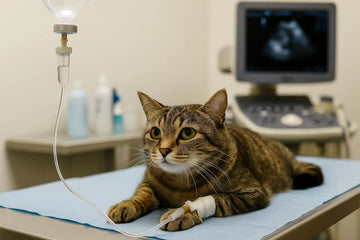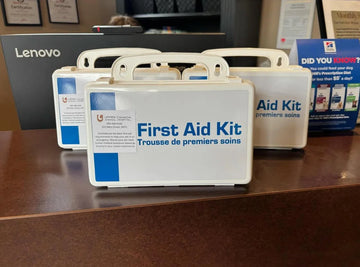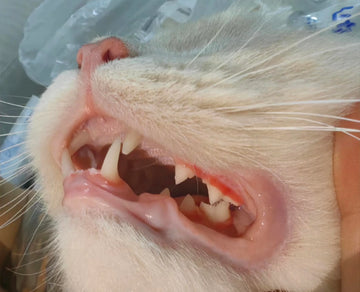Updated: October 2025 · Read time ~18–25 minutes
Even well-prepared travelers hit bumps: a sudden bout of diarrhea mid-road trip, vomiting after a bumpy flight, or heat-related nausea during a long layover. The goal of this guide is calm, not panic. Below you’ll find a practical triage flow, how to decide “watch vs. vet,” what to do differently on the road vs. at the airport, a simple rehydration plan, and what to pack so you’re never stuck improvising. If your itinerary includes air travel, bookmark our airport roundup—airline pet policy news today 2025—and if you’re driving, pair this with our road guide: Road Trips with Pets.
1) Quick Health Signals: What Matters in the First 10 Minutes
Green-light observations (monitor, adjust plan)
- One-time vomit or loose stool, bright/alert otherwise.
- Still drinking water; normal gum color (bubble-gum pink).
- No abdominal pain when gently palpated; normal posture.
Red-flag signs (seek veterinary care now)
- Repeated vomiting (≥ 3x in 6 hours) or blood in vomit/stool.
- Lethargy, collapse, painful or distended abdomen, pale/blue gums.
- Heat distress: heavy panting, drooling, wobbliness, rectal temp ≥ 104°F (40°C).
- Foreign-body risk: chewed toy pieces, socks, bones, corncobs, trash.
- Puppies, seniors, brachycephalics (Frenchies, Pugs), or chronic conditions (pancreatitis, heart disease) showing symptoms.
How to check hydration: Lift a small fold of skin over the shoulder—if it stays tented, dehydration is likely. Check gums: sticky/dry suggests dehydration. When in doubt, call a vet.
2) Triage Flow: When to Monitor vs. Call a Vet
| Situation | Do Now | Monitor Window | Escalate If |
|---|---|---|---|
| Single vomit; otherwise bright | Withhold food 6–8h (water allowed); short, calm walks | 12–24h | Vomit repeats; water won’t stay down; lethargy develops |
| Soft stool/diarrhea; no blood | Switch to bland diet (see below); probiotics if you packed them | 24–48h | Blood/mucus; fever; worsening frequency; painful abdomen |
| Motion sickness on drive | Cool cabin; shorter hops; window shades; consider vet-approved antiemetic next leg | Next 6–12h | Persistent vomiting despite rest and climate control |
| Heat exposure | Move to A/C; cool with damp cloths; small sips of water | Immediate | Temp ≥104°F/40°C, collapse, neuro signs → ER now |
| Possible foreign body | Stop food; no emesis attempts without vet guidance | — | Call nearest ER/urgent vet immediately |
3) Common Travel Triggers (and Your First Moves)
Dietary indiscretion
New treats, human food, river/lake water, or scavenged picnic leftovers are classic culprits. Start bland diet + probiotics; monitor 24–48h.
Motion & stress
Vibration + novelty = nausea. Cool, quiet cabin; short legs; consider vet-prescribed antiemetic/anxiolytic trialed at home.
Water changes
Hardness/mineral shifts can upset GI. Carry your own water; mix local water in gradually over a day.
Heat & dehydration
Travel schedules disrupt normal drinking. Offer small, frequent sips; use collapsible bowls; take shade breaks.
Infectious GI (kennels, dog parks)
Keep vax current; avoid shared bowls. If diarrhea plus fever/lethargy → vet.
Existing conditions
History of pancreatitis, IBD, or food allergies? Pack vet-approved food and meds; avoid high-fat restaurant scraps.
Cat owner too? Our companion piece on feline tummy upsets has home-care tips and red flags: Cat Gastroenteritis.

4) Road vs. Air: What Changes in Your Response
On the road
- Own schedule. Build a 2–3h stop rhythm; add shade and short walks.
- Climate control. Keep cabin cool; no “heads-out” windows (eye/ear risks).
- Reroute freedom. Pause a day if needed—choose pet-friendly lodging near a 24/7 ER.
Planning a driving trip? Use our packing and safety playbook: Road Trips with Pets.
At the airport / in the air
- If a dog vomits or has sudden diarrhea pre-flight, evaluate fitness to fly. Clean gently; offer water; consider delaying if repeated or if lethargic.
- Know relief-room locations and airline rules. See our hub: airline pet policy news today 2025.
- Always remove the pet from the carrier at TSA; carrier goes through X-ray empty.
5) Rehydration & Bland Diet Protocol (Travel-Safe)
Rehydration
- Offer small sips every 10–15 minutes for the first hour. If tolerated, increase volume gradually.
- Electrolyte solutions for dogs (vet-approved). Avoid sweet sports drinks.
- Ice chips are useful for nausea if water triggers vomiting.
Bland diet (12–24h after last vomit)
- Boiled chicken/turkey (skinless) + plain white rice (1:2 ratio), small portions 3–4×/day.
- Alternatives: vet-recommended GI canned diet; pumpkin (plain, no spices) can help stool consistency.
- Probiotics your dog already tolerates; avoid introducing brand-new supplements mid-trip.
Do not give human meds (ibuprofen, acetaminophen, bismuth subsalicylate, loperamide) without veterinary guidance—some are toxic or inappropriate depending on the cause.
6) The Travel Canine First-Aid & Med Kit (Pack List)
| Category | Items | Why It Helps |
|---|---|---|
| Hydration | Collapsible bowls; bottled water; dog-safe electrolyte solution | Prevents dehydration; avoids sudden water source changes |
| GI support | Vet-approved antiemetic (e.g., maropitant); probiotic you already use | Controls nausea; supports gut during diet switches |
| Food | Pre-measured base diet; GI canned diet; plain rice packets | Consistency beats improvisation when upset hits |
| Cleaning | Gloves, waste bags, paper towels, enzyme cleaner, pee pads | Fast cleanup for hotel/car; avoids extra fees |
| Vitals | Digital thermometer (rectal), lubricant, alcohol wipes (for tools) | Objective data for your vet; never rely on “feels warm” alone |
| Docs | Vaccine/rabies certs, insurance card, primary vet contact, recent photo | Smooths ER intake and travel checks |
| Comfort | Favorite blanket, chew, calming playlist; carrier/crate with familiar scent | Reduces stress—the hidden fuel for nausea |
7) Finding a Vet on the Road (Fast, Smart, Safe)
- Search by “Emergency Veterinary Hospital” + city. Prefer hospitals listing 24/7 hours and onsite diagnostics (X-ray, ultrasound, lab).
- Call before you drive. Give: breed/age, symptoms, duration, any known ingestion, temperature if taken, meds given.
- Ask the right two questions: (1) Average wait times now? (2) Do you triage arrivals by severity?
- Bring records: photo of vaccine card, insurance info, list of meds/supplements and last doses.
If a flight is involved the same day, factor policies and pet-relief logistics: airline pet policy news today 2025.
8) Hotels, Rentals & Cleaning Fees: Damage Control Scripts
Accidents happen. What you say at the desk matters:
Script: “We had a pet accident in the room.”
“Hi, I’m in Room 314. My dog had an upset stomach—already cleaned with enzyme spray and pads. Could we get extra towels and a small trash liner? We’re happy to cover any standard pet cleaning fee.”
Car cleanup routine (5 minutes)
- Park in shade; windows up for A/C.
- Remove solids with gloves/bags; blot—not rub—liquid.
- Apply enzyme cleaner; lay a pee pad to wick; replace seat cover if soaked.
9) Pet Insurance & Receipts: Make Reimbursement Easy
- Ask the clinic for an itemized invoice with diagnosis codes if available.
- Keep photos of packaging/labels for any prescriptions dispensed en route.
- Submit claims within the window; attach travel context notes (useful for timeline clarity).
10) Prevention: Training, Packing, and Route Choices
Training
- Carrier or seat-belt harness comfort at home (2-week plan).
- Desensitize to fueling stations and elevators.
- Practice “leash clipped before zipper” for carriers.
Packing
- Bring your dog’s usual food + probiotics to avoid sudden changes.
- Carry your own water; mix local water slowly if needed.
- Include two spare sets of bedding/pee pads.
Route & climate
- Choose shaded breaks and earlier driving windows in heat waves.
- Time airport connections where relief rooms are airside (see airline pet policy news today 2025).
- Keep fresh seat covers; bring a spare to swap after incidents.
Many travelers like a small token to “carry the journey” even when a pet stays home—our handcrafted car ornaments keep a familiar face in view: custom 3d dog ornaments.

11) After-Travel Recovery: When to Resume Normal Diet/Activity
- Once symptom-free for 24h, taper bland diet: 50/50 mix with normal food for 1–2 meals, then return to baseline if no setbacks.
- Resume regular walks first; delay strenuous hikes or dog-park play for 48h after GI symptoms resolve.
- If diarrhea/vomiting recurs after reintroduction, call your vet—consider stool testing or diet trial.
12) FAQ: Meds, Human Drugs, Multi-Dog Trips, Cats
Can I use human anti-diarrheals?
Don’t—some are unsafe in dogs and can mask serious issues. Call a vet for species-appropriate options.
What’s a reasonable “watchful waiting” period?
One mild episode with a bright dog: 12–24h with water and rest. Anything repeated or paired with lethargy/fever/blood → vet.
Traveling with multiple dogs—can one infect the other?
Yes, depending on cause. Separate bowls and walks; sanitize accidents; monitor both. If infectious disease suspected, ask the vet about isolation.
My cat is sick on the same trip—where should I start?
Different species, different playbook. Begin here for feline-specific steps: Cat Gastroenteritis.
Is it okay to fly the same day after an upset?
Only if your dog is bright, hydrated, and symptom-free for several hours. If in doubt, rebook. Review relief-room locations and airline rules at airline pet policy news today 2025.
Any small “comfort keepsake” ideas if we pause a trip?
A travel-scale memento can soften a disrupted itinerary—our rearview-mirror keepsakes keep a familiar face close: custom 3d dog ornaments.





